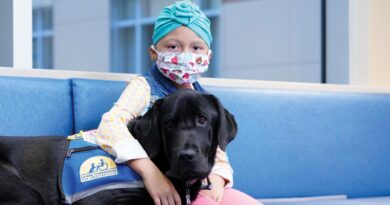Life after Transplant
Published on June 14th, 2016 by user.
Every time 10-year old Hayley Voorhees visits Monroe Carell Jr. Children’s Hospital at Vanderbilt she brings home a memento of sorts.
Syringes, tourniquets, masks, medical tape, medicine cups and the like fill a plastic bin Hayley uses for medical play with her dolls and stuffed animals. The collection, amassed over many hospital and clinic visits, documents her medical journey.
When Hayley was born, she appeared healthy. But after a few weeks at home, her jaundiced skin color and white stool sent her to the pediatrician. That visit led to a trip to the Children’s Hospital Emergency Room.
Diagnosed with biliary atresia, a life-threatening liver and bile duct disease that occurs in infancy, Hayley was admitted and had her first surgery at 4 weeks old in 2005. Biliary atresia is also the most common reason pediatric patients need liver transplantation. The disease affects about one in 16,000 children.
On Nov. 22, 2015, Hayley brought home her most precious keepsake to date—a new, healthy liver.
Living life to the fullest is evident as soon as you meet Hayley.
Firecracker, animated, very friendly, energetic, silly, a riot, high energy, diva, princess, funny, big personality, and happy, happy, happy are just a few of the words family members and clinicians use to describe Hayley, who has been treated at Children’s Hospital since she was 3 weeks old.
“I don’t know how to explain it—she is just always happy,” chuckled Sandra Voorhees, Hayley’s mom. “She’s has always been that way.”
The only time Hayley’s demeanor changes is when she hears she is being released from the hospital, but has to stay an additional day or more.
“I’m looking forward to NOT being in the hospital,” said Hayley, with a big grin.
When asked why she is always so happy, she shrugged her shoulders, batted her long eyelashes and giggled. “I don’t know. I just am!”
Expanded care for pediatric liver patients
With the addition of a pediatric liver transplant program last year at Children Hospital, patients such as Hayley who have more complex medical conditions can access some of the best specialists and surgeons in caring for pediatric liver issues. Their ability to treat this population of patients has greatly expanded. Other pediatric disorders typically treated with transplantation include obstructive biliary tract liver disease, metabolic diseases, acute and chronic hepatitis, and malignant (cancerous) liver tumors.
“There is no better place in Tennessee than Children’s Hospital to care for infants, young children and adolescents who have liver disease, which also provides the option of liver transplantation,” said Douglas Hanto, M.D., Ph.D., director of the Vanderbilt Transplant Center and chief of the Pediatric Liver Transplant Program. “The Vanderbilt Transplant Center has always had a spectacular reputation both nationally and internationally. Similarly, so does Children’s Hospital, which offers liver, heart, kidney and stem cell transplantation.”
With biliary atresia the bile becomes trapped and damages the liver, which leads to scarring and makes it difficult for the organ to remove toxins from the blood. Over time, the toxins increase leading to liver deterioration.
The Kasai procedure is typically the first treatment surgeons perform in an attempt to restore bile flow from the liver into the intestines. The surgeon removes a portion of the liver where the bile ducts are normally and directly connects a portion of the small intestine to the liver to drain the bile. Unfortunately, it is not always a cure.
About two-thirds, or 67 percent, of patients will have pigmented stools, caused by lack of bilirubin reaching the intestines, in the first couple of weeks after the Kasai is performed, according to Hanto.
Half of those patients, or 35 percent, said Hanto, will continue to properly drain bile and experience long-term relief. The other half will experience some remission of symptoms and ultimately develop inflammation that leads to scarring (cirrhosis) and portal hypertension resulting in the need for a transplant. The remaining 30 percent of patients, where the Kasai was not successful, will continue to experience white stool and within months will develop liver failure and require a transplant.
Although Hayley’s bile flow was re-established as an infant, she still had chronic liver disease. She went nearly 10 years before her health began to deteriorate due to frequent bouts of cholangitis, or inflammation of the bile ducts. She was placed on the liver transplant waiting list in the fall of 2015.
Thankfully, Hayley only waited about four weeks before receiving her liver. Hanto performed the nearly 12-hour long transplant on Nov. 22.
“Children under the age of 12 get preference for livers from donors under 35 years of age,” said Hanto. “Although there is a shortage of livers, pediatric patients get priority based on PELD (Pediatric End-Stage Liver Disease) scores, which incorporate growth and development.
Established in 2002, the PELD Score determines disease severity, likelihood of survival and priority listing for patients. It is a calculation using a very specific formula approved by the Organ Procurement and Transplant Network (OPTN) and United Network for Organ Sharing (UNOS) for allocation of livers.
“Nationally 80 percent of children under the age of 12 will be transplanted within six months, and 90 percent will be transplanted within a 12-month period,” he added, citing data from the Scientific Registry for Transplant Recipients. “Very few children die while waiting for a liver.”
Developing a comprehensive program
As head of the Transplant Program, Hanto has his sights set on developing a comprehensive pediatric liver disease and transplant center at Children’s Hospital. He anticipates his pediatric liver transplant team will perform 10 to 15 liver transplants a year and begin serving as the Southeastern regional referral center for children.
“Our goal is to build a liver center that would include medical, surgical and transplant components to care for children with congenital and metabolic liver conditions that are uncommon. Not only is there a need for such a program, but the expertise and support are already here to move forward with plans,” said Hanto.
No stranger to building nationally recognized liver transplant programs—he has three under his belt—Hanto said the pediatric program will allow children in the region with liver disease to receive world-class care close to home.
Bringing a pediatric liver transplant service into the fold of a well-established and successful transplant center, one that boasts outstanding outcomes, helps to highlight the expertise and support that already exists at Vanderbilt, Hanto said.
“The program that we started may have been new, but our medical, surgical and transplant teams are very experienced. This is a very exciting time for us.”
Hanto expects to integrate the newest innovative and technological solutions as he plans to create a comprehensive pediatric liver disease and transplant center including:
• An immunocompromised host consult service for all pediatric transplants. Established by Infectious Diseases, it is designed to offer input into the care of patients whose immune systems are suppressed or impaired.
• Discussions about combined heart/liver transplants for a special subset of patients with congenital heart abnormalities, who as they age, may develop liver failure requiring the transplantation of both organs.
• The expansion of the care of patients with congenital errors of metabolism, rare genetic disorders in which the body cannot properly turn food into energy.
Familiar faces
Pediatric liver transplant patients and families will continue in the familiar and supportive environment they have grown accustomed to with the liver medical team.
A veteran of the transplant program, Lynette Gillis, M.D., assistant professor of Pediatrics and director of Pediatric Hepatology and Liver Transplantation at Children’s Hospital, has led the multidisciplinary team of clinicians caring for this patient population.
“We continue to have a very large and active pediatric liver clinic patient population,” Gillis said. “Families travel a long distance to come here, some driving three to four hours. Having a regional center will make a huge difference for them, especially in terms of family and community support.”
Gillis’ clinic has roughly 1,000 patient visits annually, with 10 to 15 patients requiring liver transplantation every year.
Gillis has treated Hayley since 2007.
“She’s a little bit of sunshine when she comes into clinic,” said Gillis. “It is so much fun to see her. She just seems to brighten things up around here. She is an example of why our work is rewarding and why any of us do what we do—it’s for patients like Hayley and her family.
“I want her to have a long and happy life,” said Gillis. “I want to be able to attend her graduation and show up at her wedding.”
Gillis’ wish for Hayley is similar to that of her family—“letting her grow up, be a healthy kid and be as normal as possible.”
“It’s interesting,” said Sandra Voorhees. “None of our dreams for her have changed. We’ve always wanted the same thing. For me, the biggest things will be that I have gotten very used to watching her closely for signs of illness. That’s instinctual for me, and I’ll have to learn to transition from that.”
Although Voorhees said seeing her daughter soon after her transplant was a moment she will never forget.
“There was an immediate change,” said an amazed Voorhees. “You could see it in her skin color and the whites of her eyes. They were really bright. It’s like someone turned the lights on behind her eyeballs.”
But she also said they dimmed a bit when Hayley asked a few days post transplant where her liver came from.
“She doesn’t talk much about what she has gone through,” said her dad, Ronnie Voorhees. “The only thing that I have noticed that really upset her is when we told her how she got her liver. Since she asked us, we told her.
“That was a really hard thing to talk to her about,” he said shaking his head. “I mean we knew that for her to get her liver, someone else had to die. It’s part of it all, but what a huge sacrifice people make. They gave us the ultimate gift.”
Hayley has no restrictions in terms of activity, but will continue to see Gillis for follow-ups and managing the adjustments to her medications, which include a lifetime of anti-rejection drugs.





